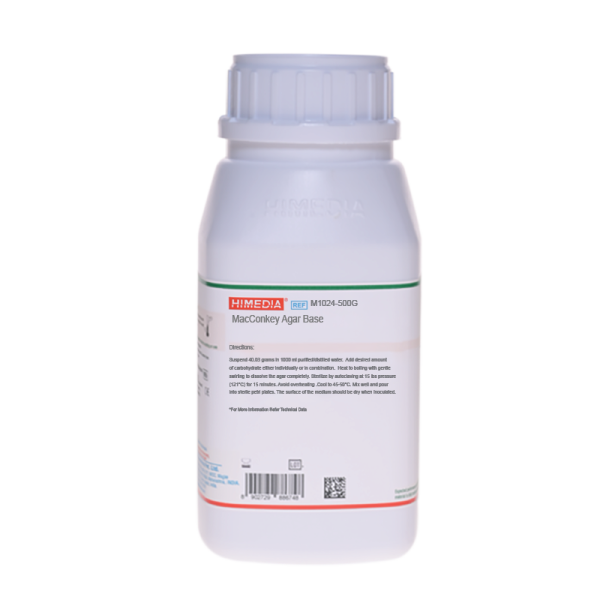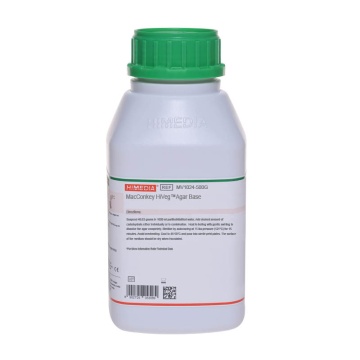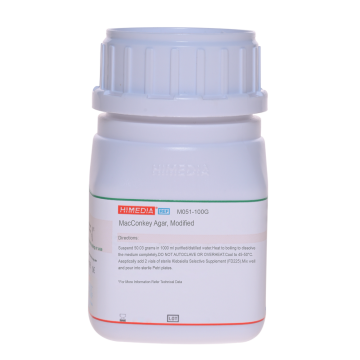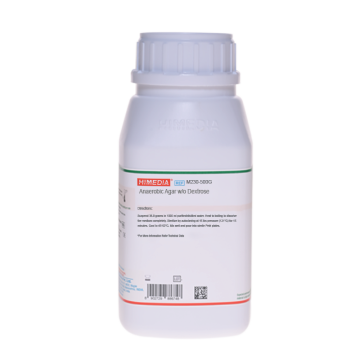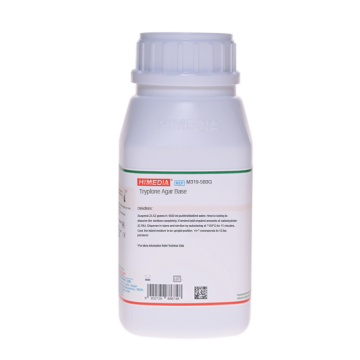 Your enquiry has been submitted
Your enquiry has been submitted
MacConkey Agar Base
Intended Use:
Recommended for studying carbohydrate fermentation reactions of coliforms by adding carbohydrates either individually or in combination.
Composition**
| Ingredients | g/L |
|---|---|
| Peptone | 17.000 |
| Proteose peptone | 3.000 |
| Bile salts | 1.500 |
| Sodium chloride | 5.000 |
| Neutral red | 0.030 |
| Crystal violet | 0.001 |
| Agar | 13.500 |
Final pH (at 25°C): 7.1±0.2
**Formula adjusted, standardized to suit performance parameters
Directions
Suspend 40.03 grams in 1000 ml purified/distilled water. Add desired amount of carbohydrate either individually or in combination. Heat to boiling with gentle swirling to dissolve the agar completely. Sterilize by autoclaving at 15 lbs pressure (121°C) for 15 minutes. Avoid overheating. Cool to 45-50°C. Mix well and pour into sterile petri plates. The surface of the medium should be dry when inoculated.
Principle And Interpretation
MacConkey Agar is the earliest selective and differential medium for cultivation of enteric microorganisms from a variety of clinical specimens (1,2). MacConkey Agar Base is used for studying carbohydrate fermentation reactions of coliforms by adding carbohydrates either individually or in combination (3). MacConkey Agar Base has peptone and proteose peptone, which provide nitrogen, carbon and vitamin source for the growth of bacteria. This medium does not contain carbohydrates. However for studying fermentation reaction, carbohydrate of interest has to be added while preparing medium. The selective action of this medium is attributed to bile salts and crystal violet, which are inhibitory to most of the species of gram-positive bacteria. Gram-negative bacteria usually grow well on the medium and are differentiated by their ability to ferment carbohydrates. Carbohydrate fermenting strains grow as red or pink and may be surrounded by a zone of acid precipitated bile. The red colour is due to production of acid from carbohydrate, absorption of neutral red and subsequent colour change of the dye when the pH of the medium falls below 6.8. Sodium chloride helps to maintain osmotic balance.
Type of specimen
Clinical samples: Urine, faeces; Food and dairy samples; Water samples.
Specimen Collection and Handling
- For clinical samples, follow appropriate techniques for sample collection and processing as per guidelines (4,5).
- For food and dairy samples, follow appropriate techniques for sample collection and processing as per guidelines (6,7).
- For water samples, follow appropriate techniques for sample collection and processing as per guidelines (8).
- After use, contaminated materials must be sterilized by autoclaving before discarding.
Warning and Precautions:
In Vitro diagnostic use. For professional use only. Read the label before opening the container. Wear protective gloves/ protective clothing/eye protection/face protection. Follow good microbiological lab practices while handling specimens and culture. Standard precautions as per established guidelines should be followed while handling clinical specimens. Safety guidelines may be referred in individual safety data sheets.
Limitations
- Individual organisms differ in their growth requirement and may show variable growth patterns on the medium.
- Each lot of the medium has been tested for the organisms specified on the COA. It is recommended to users to validate the medium for any specific microorganism other than mentioned in the COA based on the user's unique requirement.
- Further biochemical and serological testing must be carried out for further confirmation.
- The surface of the medium should be dry when inoculated.
Performance and Evaluation
Performance of the medium is expected when used as per the direction on the label within the expiry period when stored at recommended temperature.
Quality Control
Appearance: Light yellow to pink homogeneous free flowing powder
Gelling: Firm comparable with 1.35% Agar gel.
Colour and Clarity of prepared medium: Red with purplish tinge clear to slightly opalescent gel forms in Petri plates.
Reaction: Reaction of 4.0% w/v aqueous solution at 25°C. pH: 7.1±0.2
pH: 6.90-7.30
Cultural Response
Cultural characteristics observed with added 1% lactose, after an incubation at 35-37°C for 18-24 hours.
| Organism | Inoculum (CFU) | Growth | Recovery | Colour of Colony |
|---|---|---|---|---|
| Escherichia coli ATCC 25922 (00013*) | 50-100 | luxuriant | >=50% | pink to red with bile precipitate |
| Klebsiella aerogenes ATCC 13048 (00175*) | 50-100 | luxuriant | >=50% | pink to red |
| Enterococcus faecalis ATCC 29212 (00087*) | 50-100 | fair to good | 30-40% | pale pink to red |
| Proteus vulgaris ATCC 13315 | 50-100 | luxuriant | >=50% | colourless |
| Salmonella Paratyphi A ATCC 9150 | 50-100 | luxuriant | >=50% | colourless |
| Shigella dysenteriae ATCC 13313 | 50-100 | fair to good | 30-40% | colourless |
| Salmonella Paratyphi B ATCC 8759 | 50-100 | luxuriant | >=50% | colourless |
| Salmonella Enteritidis ATCC 13076 (00030*) | 50-100 | luxuriant | >=50% | colourless |
| Salmonella Typhi ATCC 6539 | 50-100 | luxuriant | >=50% | colourless |
| Staphylococcus aureus subsp. aureus ATCC 25923 (00034*) | >=104 | inhibited | 0% |
Key :(*) Corresponding WDCM numbers
Storage and Shelf Life
Store between 10-30°C in a tightly closed container and the prepared medium at 2-8°C. For better performance it is advised to store the plates at 2-8°C. Use before expiry date on the label. On opening, product should be properly stored dry, after tightly capping the bottle inorder to prevent lump formation due to the hygroscopic nature of the product. Improper storage of the product may lead to lump formation. Store in dry ventilated area protected from extremes of temperature and sources of ignition. Seal the container tightly after use. Product performance is best if used within stated expiry period.
Disposal
User must ensure safe disposal by autoclaving and/or incineration of used or unusable preparations of this product. Follow established laboratory procedures in disposing of infectious materials and material that comes into contact with clinical sample must be decontaminated and disposed of in accordance with current laboratory techniques (4,5).
Reference
- MacConkey, 1900, The Lancet, ii:20.
- MacConkey, 1905, J. Hyg., 5:333.
- Holt, Harris and Teague, 1916, J. Infect. Dis., 18:596.
- Isenberg, H.D. Clinical Microbiology Procedures Handbook. 2nd Edition
- Jorgensen, J.H., Pfaller, M.A., Carroll, K.C., Funke, G., Landry, M.L., Ricther, S.S and Warnock., D.W. (2015) Manual of Clinical Microbiology, 11th Edition. Vol. 1.
- Salfinger Y., and Tortorello M.L., 2015, Compendium of Methods for the Microbiological Examination of Foods, 5th Ed., American Public Health Association, Washington, D.C.
- Wehr H. M. and Frank J. H., 2004, Standard Methods for the Microbiological Examination of Dairy Products, 17th Ed., APHA Inc., Washington, D.C.
- Lipps WC, Braun-Howland EB, Baxter TE, eds. Standard methods for the Examination of Water and Wastewater, 24th ed. Washington DC:APHA Press; 2023.
| Product Name | MacConkey Agar Base |
|---|---|
| SKU | M1024 |
| Product Type | Regular |
| Physical Form | Powder |
| Origin | Animal |
| Packaging type | HDPE |
| References | 1. MacConkey, 1900, The Lancet, ii:20. |
| Customized Product Available | No |



